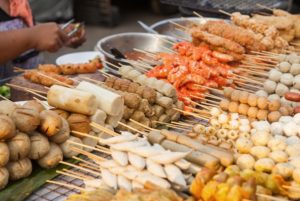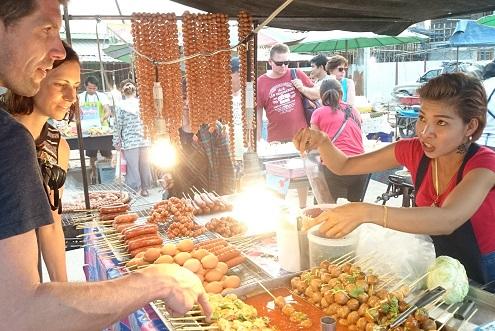Travelling Thailand and not testing its street food, makes your Thailand-tour incomplete. It’s not very hard to find a street corner with a row of carts lined up dishing up Thai street foods like noodle soup, BBQ pork, fish cakes and delicious curries. Geographically positioned at an Asian intersection for centuries, Thailand owes its rich cuisine to the culinary infusions of India, China, Malaysia and Indonesia. Although the cooking techniques and ingredients of Thai foods are highly influenced by each of these country’s cuisines, still it retains its originality by blending them with its own. Like all other Asian nations, Bangkok, the capital city of Thailand, also helps feeding millions of people daily with its mouthwatering street foods and the best part is that it’s generally safe since these are made right in front of you and it’s ingredients are fresh as well. Additionally it gives you a chance to interact with the locals, and it is the best way to give back to the local economy.
Like all other Asian nations, Bangkok, the capital city of Thailand, also helps feeding millions of people daily with its mouthwatering street foods and the best part is that it’s generally safe since these are made right in front of you and it’s ingredients are fresh as well. Additionally it gives you a chance to interact with the locals, and it is the best way to give back to the local economy.
Thai food’s basic flavor is characterized by four elemental tastes of salty, sweet, sour and pungent. Ingredients like lemongrass, fresh coriander leaves, lime juice, ginger, garlic, chilies, tamarind juice, fish paste, and coconut milk are used generously in it. Maintaining the delicate flavours of the food, the street food vendors here are experts in combining these ingredients and making some magical dishes out of these with their instant cooking techniques.
Not only in Bangkok but in all of Thailand, eating Thai street foods are incredibly cheap. A bag of fish cakes will cost you just 20 baht (less than a $1) and a noodle soup around 60 baht ($2). Although Bangkok holds some world-class gourmet restaurants, its street foods are the real attractions with so much varieties.
Vendors here prefer to expertise in one particular dish at a time. Some of the favourites street foods here are :
* Thotman plakrai or thotman kung (Thai style fish or shrimp fritters)
* Kai ho bai toei (seasoned fried chicken wrapped in leaves)
* Different kinds of yam (Thai salads)
* Tomyam (hot and sour soup)
* Gaeng kiow wan gai (green chicken curry).
In order to complement your street dinning with something sweet in the end, you can go for :
* khao niew mamuang (sticky rice with mango)
* kruay kaek (banana fritters)
or simply you can choose from a selection of sliced fresh fruits from one of the roaming carts.
Apart from fixed shops at the sidewalks, you can also find hawkers on foot just about anywhere from crossing a busy crossroad to do a brisk trade outside. Carrying filled baskets balanced on a wooden yoke upon one shoulder, they haul around noodles, vegetables, spices, plates, a small stove and a stool etc to sasiate the hunger with a quick roadside meals. Most Bangkokians irrespective of all classes eat at these one-dish specialist stalls, perched on tiny stools as the traffic hurtles by, because they serve the freshest, most authentic and delicious Thai cooking.
Another common sight along the streets of Bangkok is the pushcart or tricycle cart, a simple variant of the bicycle or motorcycle pushing a large-wheeled box fully equipped to make delicious food. Sellers paddle their mini-shops from home-to-home, offering “boat noodles”, curries over rice and an assortment of kanom (sweetmeats and snacks), along the canals and waterways.
With all diversities and delicacies Thai cuisines are certainly deserve to be explored on your next trip to the country.

